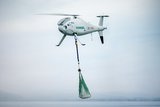Leidos’ autonomy system completes voyage
Leidos’ prototype autonomous maritime system for the DARPA Anti-Submarine Warfare Continuous Trail Unmanned Vessel (ACTUV) programme recently completed its first self-guided voyage between Gulfport and Pascagoula, Mississippi, the company announced on 26 January.
The prototype system was installed on a 42-foot work boat that served as a surrogate vessel to test sensor, manoeuvring, and mission functions of the prototype ACTUV vessel. ACTUV seeks to develop an independently deployed, unmanned naval vessel that would operate under sparse remote supervisory control and safely follow the collision avoidance ‘rules of the sea’.
Controlled only by the autonomy system, and with only a navigational chart of the area loaded into its memory and inputs from its commercial-off-the-shelf (COTS) radars, the surrogate vessel successfully sailed the complicated inshore environment of the Gulf Intracoastal Waterway. During its voyage of 35 nautical miles, the maritime autonomy system functioned as designed. The boat avoided all obstacles, buoys, land, shoal water, and other vessels in the area – all without any pre-planned waypoints or human intervention.
While Leidos continues to use the surrogate vessel to test ACTUV software and sensors, the company is continuing construction of Sea Hunter, the first ACTUV prototype vessel, in Clackamas, Oregon. Sea Hunter is scheduled to launch in late fall 2015 and begin testing in the Columbia River shortly thereafter.
More from Uncrewed Vehicles
-
Jammer resistant drone designs spark search for countermeasures
The Russia-Ukraine conflict has driven another stage of evolution for drones and the counter measures to defend against them.
-
![L3Harris launches Amorphous software for control of uncrewed platforms]()
L3Harris launches Amorphous software for control of uncrewed platforms
The new Amorphous software is a universal controller that would allow a single operator to control a swarm of “thousands” of uncrewed systems, from drones to underwater platforms.
-
ideaForge unveils new UAVs at Aero India 2025
India UAV supplier ideaForge has launched the Netra 5 and Switch V2 drones at Aero India 2025, boasting of enhanced endurance, AI-driven autonomy and improved operational capabilities.
-
![Shaping the future of defence: What 2025 holds for the global drone market]()
Shaping the future of defence: What 2025 holds for the global drone market
The UAV market is experiencing unprecedented growth, with innovations in technology and battlefield applications driving demand across military sectors. From the battlefields of Ukraine to NATO exercises and beyond, drones are transforming how wars are fought and supported.
-
![Maris-Tech confirms customers signing up for Jupiter Drones codec and AI-powered system]()
Maris-Tech confirms customers signing up for Jupiter Drones codec and AI-powered system
Launched at AUSA in October, the company’s multi-stream video codec is attempting to bring a new lease of life to drone technology through its AI accelerator.
-
![AUSA 2024: Quantum-Systems targets big 2025 with UAS developments]()
AUSA 2024: Quantum-Systems targets big 2025 with UAS developments
Quantum-Systems has been upgrading its UAS family, with new versions of the Vector, Reliant and Twister drones set for release throughout 2025.
























